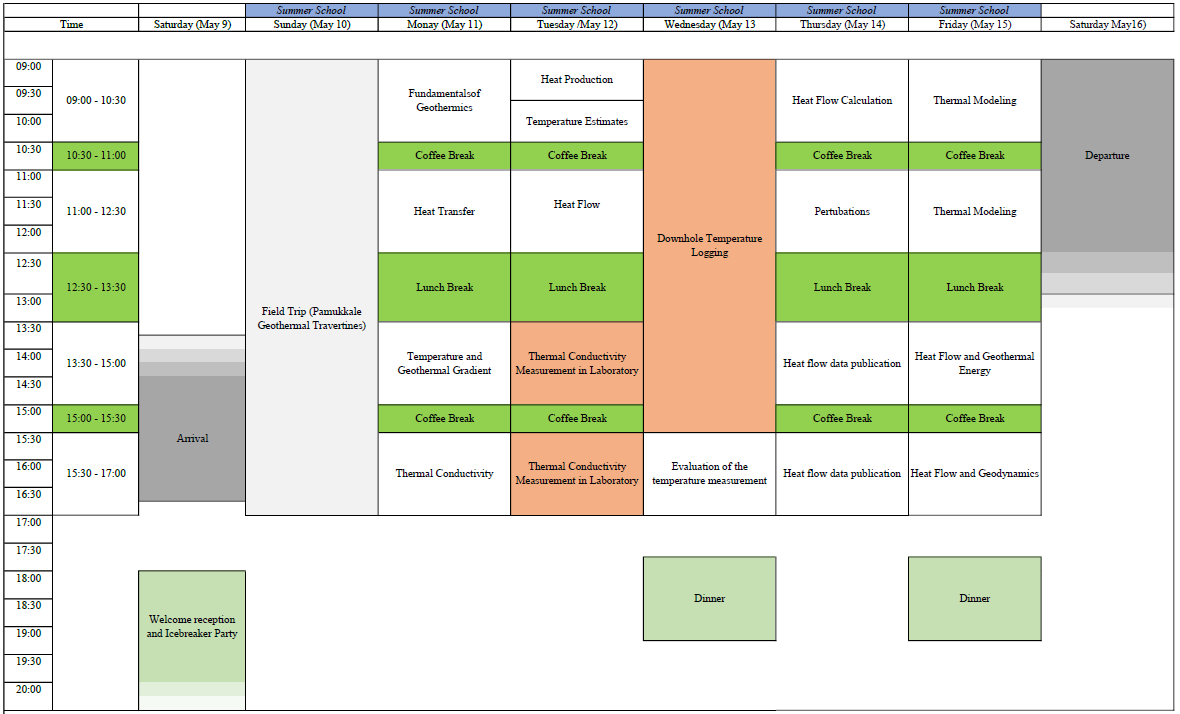
Summer school topics
Day 1 - Sunday
Field Trip: Pamukkale Geotravertines (wikipedia) A full-day excursion to Pamukkale, famous for its carbonate travertine terraces created by geothermal spring activity in the Denizli geothermal province. Participants will explore this natural laboratory to understand the surface expressions of geothermal processes
Day 2 - Monday
Fundamental of Geothermics/Heat Transfer Introduction to heat transfer processes in the Earth’s crust, enabling participants to understand the distribution and evolution of heat and temperature. The session covers both theoretical background and practical aspects, including methods for determining thermo-physical properties, data acquisition, processing, and interpretation in the context of geodynamic processes and subsurface utilization.
Temperature and Geothermal Gradient This session provides an overview of the main temperature sensors used in geothermal studies, including mercury and metallic expansion thermometers, Pt resistances, thermistors, thermocouples, and fiber-optic cables. Emphasis will be placed on accuracy, calibration, and survey techniques, such as stop-start precision logging, continuous logging, and fiber-optic monitoring, with a focus on determining geothermal gradients in continental settings.
Thermal Conductivity Measurements Overview of the methods, challenges, and strategies for measuring the thermal conductivity of rocks is the main topic of this session. It also covers sample preparation, representation of in-situ properties, anisotropy assessment, and the main measurement techniques.
Day 3 - Tuesday
Temperature Estimates and Heat Production This session provides an overview of indirect methods for estimating subsurface temperatures. Participants will learn about groundwater geothermometers, xenolith data, and seismic constraints such as Curie point depth. The fundamentals of radiogenic heat production within the crust will also be introduced, highlighting its role in controlling regional thermal regimes.
Thermal Conductivity Measurements on laboratory In the afternoon session, we will conduct on laboratory techniques for determination thermal conductivity of dry and saturated rocks under ambient conditions.
Day 4 - Wednesday
Downhole temperature logging Temperature measurements will be logged at a nearby borehole. Thermal gradient and uncertainties will also be determined.
Day 5 - Thursday
Heat Flow Calculation This session focuses on practical heat flow calculations using both field and laboratory data. We will discuss corrections for environmental effects to determine surface heat flow and examine how measurement errors influence uncertainties. The terrestrial heat flow value depends not only on the thermal gradient and rock thermal properties but also on the chosen method of combining these parameters. Classical approaches, such as the interval method and the Bullard plot, will be introduced. Key sources of uncertainty, such as temperature measurement biases, errors in thermal conductivity related to porosity estimates, and radiogenic heat generation in deep boreholes, will also be addressed.
Perturbations: Transient vs. Steady-State Heat Transfer In this session, participants will examine the distinction between steady-state and transient heat transfer. While steady-state heat transfer assumes constant temperature with time, transient heat transfer accounts for temporal changes. Sudden disturbances eventually lead to a new equilibrium, a phenomenon known as unsteady or transient heat transfer. The session will also review typical transient disturbances affecting direct heat flow measurements, emphasizing how acquisition methods and environmental factors can influence results.
Publishing Heat Flow Data In this session, we will focus on how heat flow data can be published using the World Heat Flow Portal. Participants will explore the structure of the new Global Heat Flow Database (GHFD) and actively engage with heatflow.world. The new data collected during this summer school will be compiled into a joint data publication by all participants, which will then be submitted for a DOI. Participants will become familiar with every step of the data publication process, from data preparation to submission.
Day 6 - Friday
Thermal modeling This session presents the fundamental equations of balance of energy of geological processes in steady and transient state.The finite element method for the numerical modeling thermal processes in the Earth. 1D models for isotherms of the continental crust, oceanic lithosphere, and hydrothermal circulation around a fault. 1D models of isotherms in sedimentary basins. 1D thermal perturbations caused by climate temperature changes. 2D models of the cooling of igneous bodies and heating by a strike-slip fault. 3D thermal effects.
Heat flow and geothermal energy In this session we will discover how a comprehensive understanding of crustal heat flow can greatly enhance the efficiency of exploration and characterization of geothermal energy resources. This includes ensuring that the maximum information is obtained from conventional ‘temperature gradient wells’, and that realistic values of rock and fluid properties are entered into sophisticated geothermal exploration and production modelling software. But the principles of crustal heat flow can also be applied at the regional scale to predict the temperature at any particular depth, and especially where high temperatures might coincide with productive reservoir formations. Knowing how and why heat moves in the subsurface can also help predict the redistribution of heat by convection, and aid in the interpretation of observed surface geothermal manifestations.
Heat flow and geodynamics This session discusses the rheological response of Earth materials to variations in temperature and stress. Empirical laws that describe the rheology of the different shells of the Earth are also examined: brittle and ductile deformation on the crust and lithosphere and modes of flow in the mantle. Finally, this section introduces frictional constitutive laws that describe slip-weakening in friction, stick-slip instabilities, the dynamics of earthquakes, and the temperature dependence of these of these phenomena.

